The Lynnfield Preview: Rumblings of Revenge
by Anand Lal Shimpi on May 29, 2009 1:00 PM EST- Posted in
- CPUs
SYSMark 2007 Performance
Our journey starts with SYSMark 2007, the only all-encompassing performance suite in our review today. The idea here is simple: one benchmark to indicate the overall performance of your machine.
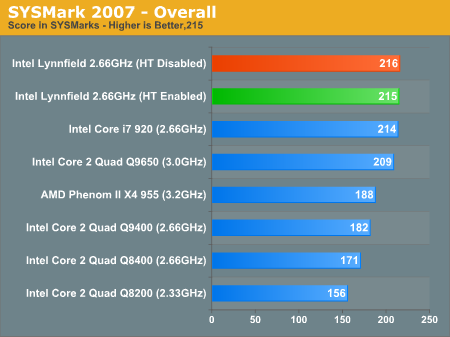
Ok. Right out of the gate, on pre-production silicon, with a pre-production motherboard and without a super aggressive turbo-mode the 2.66GHz Lynnfield sample is able to perform just as well as the i7-920. This is just as we expected given the minimal impact of triple-channel DDR3 on i7 that we pointed out in our original review.
Curiously enough, HT doesn't seem to do anything at all for Lynnfield in this test. Remember that stressing four cores is tough enough, finding eight CPU intensive threads is even more difficult.
Adobe Photoshop CS4 Performance
To measure performance under Photoshop CS4 we turn to the Retouch Artists’ Speed Test. The test does basic photo editing; there are a couple of color space conversions, many layer creations, color curve adjustment, image and canvas size adjustment, unsharp mask, and finally a gaussian blur performed on the entire image.
The whole process is timed and thanks to the use of Intel's X25-M SSD as our test bed hard drive, performance is far more predictable than back when we used to test on mechanical disks.
Time is reported in seconds and the lower numbers mean better performance. The test is multithreaded and can hit all four cores in a quad-core machine.
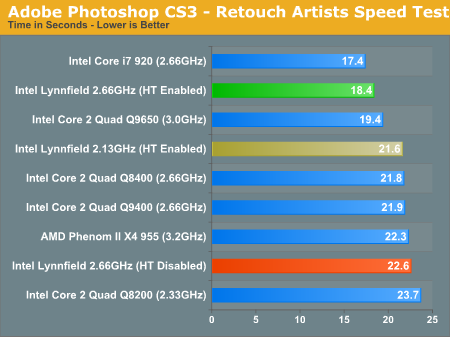
DivX 8.5.3 with Xmpeg 5.0.3
Our DivX test is the same DivX / XMpeg 5.03 test we've run for the past few years now, the 1080p source file is encoded using the unconstrained DivX profile, quality/performance is set balanced at 5 and enhanced multithreading is enabled:
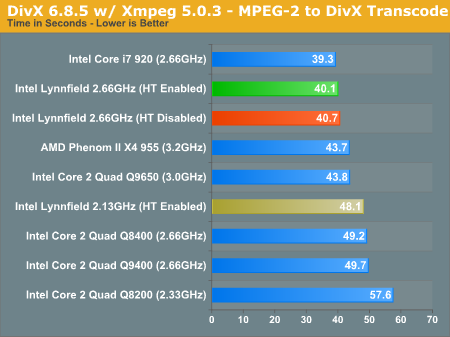
Once more, we see very little impact from Hyper Threading; the entry level Lynnfield may not be as bad as you'd think. On top of that, the crippled Lynnfield is less than 4% slower than the Core i7-920. Enable its aggressive turbo mode and I believe we'll have a chip that can actually beat, even if only slightly, the Core i7-920.
x264 HD Video Encoding Performance
Graysky's x264 HD test uses the publicly available x264 codec (open source alternative to H.264) to encode a 4Mbps 720p MPEG-2 source. The focus here is on quality rather than speed, thus the benchmark uses a 2-pass encode and reports the average frame rate in each pass.

The x264 encode test shows one application where Hyper Threading is important. A 2.13GHz Lynnfield with HT enabled is faster than a 2.66GHz Lynnfield with HT disabled, unfortunately the former isn't on the roadmap and the latter is what we're getting.
Without HT enabled the $196 Lynnfield 2.66GHz core is faster than every non-EE Penryn Core 2 Quad as well as AMD's Phenom II X4 955 (in the second pass of the test). The i7-920 is significantly faster thanks to having HT enabled; and now we have the perfect reason for Intel disabling HT on the "low end" Lynnfield.
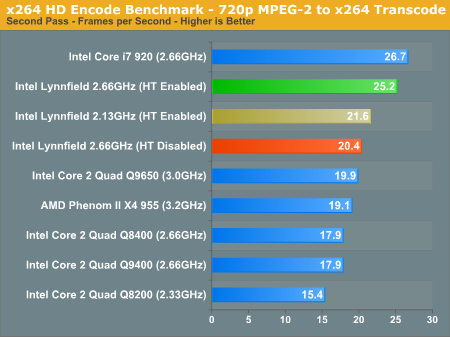
Windows Media Encoder 9 x64 Advanced Profile
In order to be codec agnostic we've got a Windows Media Encoder benchmark looking at the same sort of thing we've been doing in the DivX and x264 tests, but using WME instead.
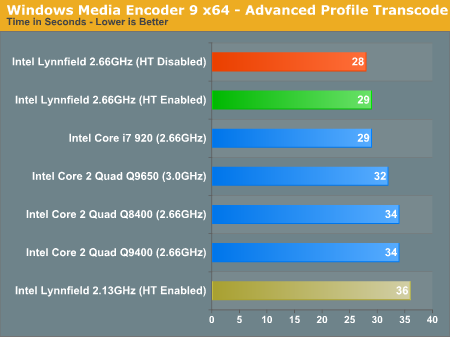
Tests that don't scale well with HT enabled, once again, show no performance difference between a 2.66GHz Lynnfield and a 2.66GHz Bloomfield.










95 Comments
View All Comments
Jabbernyx - Monday, June 1, 2009 - link
You're forgetting the $10 off promo code and 5% Live cashback ;)Randomblame - Friday, May 29, 2009 - link
Anyone else irritated that when this launches intel will have 5 sockets going?Shall we count em?
lga 775 core 2
lga 1366 i7
lga 1160 lynfield
lga 771 xeon penryn
lga 611 itanium
Did I miss any?
Anonymous Freak - Sunday, May 31, 2009 - link
If you're going to include Itanium; you might as well include the mobile sockets as well.Last October, Intel had one desktop, three server, and two mobile sockets:
LGA775 on the desktop was it.
LGA771 for dual Xeon, PGA-604 for quad-plus Xeon. (And LGA775 for single-socket servers, where the processors were just Core 2 series processors slapped with a "Xeon" name on them, so I'm keeping that with 'desktop'.) PAC-611 is Itanium.
Socket M is the slightly older mobile socket, Socket P is the newer. One could say that Socket M was already dead in October.
Early next year, we will have three desktop, two server, and two mobile sockets.
LGA 775 will be the low-end Core 2 socket, LGA 1366 for i7, and LGA 1156 for Lynnfield. Lynnfield should overtake Core 2 very quickly, especially after the integrated-graphics chips come out, and drop to two desktop sockets, though.
LGA 1366 doubles as the single and dual server socket; and the new "Nehalem EX" will in all likelihood have a new socket shared with the new Itanium (from reasonable guesses, anyway.)
Mobile will have just Socket P until the mobile Nehalems launch, when a new mobile Nehalem socket will be out.
Sorry, but LGA 771 is already dead. Its processors are completely obsolete at this point, by Nehalem-EP. And PGA-604 (which you missed,) as well as PAC-611, will be obsoleted by the Nehalem-EX socket. (Again, just guessing. The entire point of QPI was to make Xeon and Itanium share resources, so I would imagine they would use the same socket. Especially with Xeons now at higher power draw than even the highest draw Itanium; there is no reason for Itanium's goofy socket-with-power-pod arrangement any more.
Drazick - Friday, May 29, 2009 - link
Though the system looks good.I really liked the one chip Idea (Chipset).
I hope Intel eventually let nVidia develop chipsets for this platform.
Why don't you think the regular PCIE X16 lane in this system is enough for GPGPU? It might not be the best but for Encoding some movies and Accelerating Matlab it should be enough, no?
Anand Lal Shimpi - Saturday, May 30, 2009 - link
I didn't mean to imply that 16 PCIe 2.0 lanes aren't enough for GPGPU. But if you're doing a *lot* of compute over the PCIe bus, perhaps over multiple very high end GPUs, then you'll probably want QPI. This is more of a HPC or head-in-the-clouds-desktop scenario though.It should be more than enough for GPU based video encode or math.
Take care,
Anand
ssj4Gogeta - Friday, May 29, 2009 - link
Even if Intel allows Nvidia, they can't make integrated graphics for i5 because the chip is connected to the chipset via 2 GB/s DMI, which will bottleneck it.Doormat - Friday, May 29, 2009 - link
Until the price of 4GB DDR3 sticks come down (and I could put 16GB of RAM on the board), I think the i7 is where its at. At least with i7, I can go with 12GB now and then upgrade to 24GB later (12GB I need, 24GB I don't know...).A5 - Friday, May 29, 2009 - link
If you NEED 12GB, then Lynnfield isn't going to be for you. Intel would much rather you use Xeons for that kind of workload anyway :Pltcommanderdata - Friday, May 29, 2009 - link
So with mainstream Nehalems not having any QPI links and high-end Nehalems with QPI not needing them, are third-party IGPs dead? It seems that even if nVidia can win their legal issues with Intel, the technical challenges of being limited to DMI seem to make the Intel chipset business unprofitable. Higher priced chipsets with IGPs would be bandwidth limited over DMI and just making southbridges doesn't seem very glamourous or profitable.Anand Lal Shimpi - Saturday, May 30, 2009 - link
NVIDIA claims to have DMI based IGPs in development for LGA-1156 platforms. We'll see how good they are and if they do end up coming to market despite the legal issues.In the long run I don't expect the 3rd party chipset business to survive on either platform (AMD or Intel). Unless either company is horribly deficient at some basic platform need I'd expect desktop and mobile AMD CPUs to use AMD chipsets and for desktop and mobile Intel CPUs to use Intel chipsets. It may take a couple of years to get there but I think the end result is inevitable.
I believe that's why we're seeing such a strong push from NVIDIA lately with things like Ion. Attempting to stay put when we know what the tide is about to do is a difficult task.
Take care,
Anand